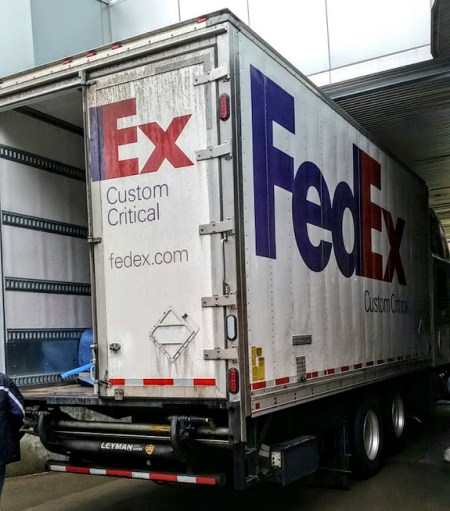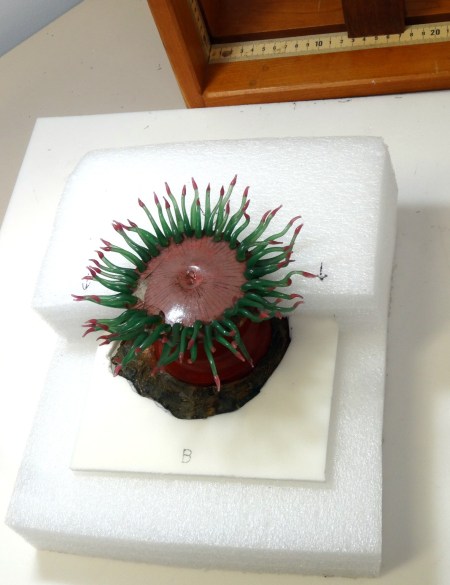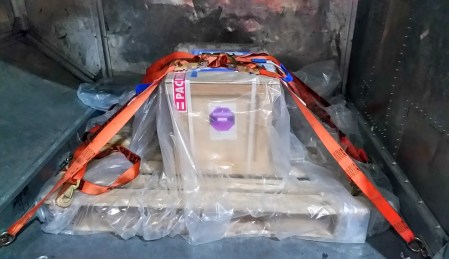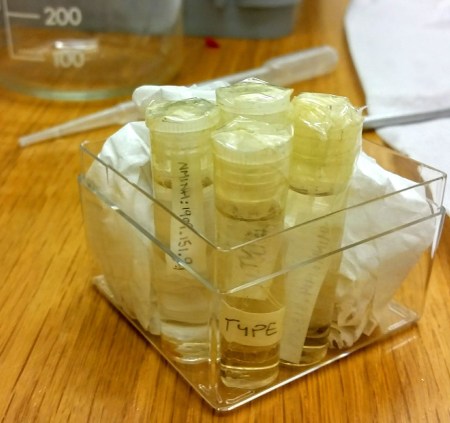
An exceptionally fragile Blaschka glass model of a radiolarian in Dublin – would you lend it?
In museums, collections are key. They are the resource that we rely on to drive our exhibitions, research, outreach, educational activities and even our marketing. We use this resource sustainably, ensuring it will be available for future generations. Our policies and standards protect them, keeping them safe by providing an appropriate environment and managing access – and while this is not always easy, at least we have control.
And then there are loans.
Loans are an area fraught with worry for the museum professional, since they take our objects from an environment that we understand and place them in a new environment that we don’t know and don’t control. There are processes and systems in place to manage this – the UKRG provide useful report templates for facilities, cases and security, so we can find out all the important details about where our object is going and how safe it will be when it gets there. There’s a lot of paperwork involved and when trying to organise insurance valuations and the various rights to take and use images it can get complicated. Of course this quagmire of agreements applies to the borrower too.
Then there is that tricky bit which involves the object moving to its temporary home. You can’t just send a delicate object from one safe, secure and cosy case to another by chucking it in the back of a van – it would rather defeat the point. That’s where art handlers and couriers come in. People trained in handling delicate objects and getting them from A to B without rendering them into a pile of dust. Of course, to do this safely the objects need to be properly packed for transport, so they are inspected, supported and carefully cushioned, to minimise the risk of damage.

Not chucked in the back of a truck. Carefully packaged, cushioned and secured in the back of an air-ride, art-handling truck.
This isn’t such a problem when taking some plastic dinosaurs around the corner (my last job at the Grant Museum was couriering a loan for the Making Nature exhibition at the Wellcome), but it was at the forefront of my mind when I was asked to courier two Blaschka glass models back from the USA during my first month in my new job as Zoology Curator at the National Museum of Ireland – Natural History (affectionately known by locals as the Dead Zoo). We have the largest collection of Blaschkas in Europe and before I started we had lent two of them to the cracking (pun intended) Corning Museum of Glass, which is in Upstate New York.

Dinosaurs from the Grant Museum of Zoology on loan to the Wellcome for ‘Making Nature’.
The Blaschkas are popular in the art world so they are quite valuable, they’re old and thin glass so they’re very fragile and because they were hand-crafted using techniques that died with Rudolf Blaschka in 1939 they are irreplaceable. So no pressure.

In the process of supporting the base of a Blaschka anemone.
I’ve had to move Blaschkas before and it’s always a bit of a nerve-wracking experience, but I was fortunate that Corning has some of the best glass conservators in the world on hand to help pack the objects. In fact, the whole trip was carefully planned by Masterpiece International and the excellent registration teams in Corning and Dublin. The people I worked with were all very experienced and diligent professionals who dealt with everything, including driving the FedEx truck, art storage, preflight clearance, in fact everything to standing on the airport tarmac overseeing the loading onto and off the plane. All I had to worry about was the objects themselves. I’m sure you’ll be relieved to know that they safely made the journey home in one piece.

The specimens crated up, strapped down and covered with sensors to tell what kid of forces it was exposed to in the hold of the plane.
On my return I had a more fiddly loan to deal with myself. The Museum has a lot of type material that needs to be accessible for scientific purposes and I had a loan request from a researcher in Italy. Now research loans aren’t like exhibition loans, since the real value of the material lies is in its scientific importance, which is only unlocked if the specimen can be used for research. The loan conditions for this sort of specimen tend to be along the lines of “send it back when you’re finished”, “cite the specimen properly when you publish” and “don’t cut it up without asking us first”.

Not as pretty as a Blaschka, but much more important to science.
Transporting these sorts of specimens is a rather different process to managing a loan for exhibition, since it is generally illegal to take specimens stored in alcohol or formalin on a plane. However, the classification of specimens as Dangerous Goods when handled by a registered carrier like FedEx or DHL changed in 2011 and as long as certain packing requirements are met specimens in fluid can be sent using a carrier.
At least in theory.
In practice it took several weeks of being passed between different departments and badgering a variety of people before I finally managed to get the package sent. The only reason I didn’t give up was the glimmer of hope from the advice I received from Miranda Lowe at the NHM (who happens to also be a valued member of the NatSCA committee) who told me the secret of the IATA Special Provision A180 to Ship Preserved Specimens and assured me it was possible. I have since managed three overseas research loans now that the systems in place. Thanks Miranda!
Managing loans is a lot of work, but it’s an important part of making collections accessible, so it is worth the effort!


A very interesting blog Paolo. I’m currently adding another spoke to the loans wheel. I am researching the possibility of developing a natural history touring exhibition with aid of a regional museum. It will your the UK, however I am looking to loan mammal specimens for the exhibition. Do you think any venues would be brave enough to let me look after their specimens and tour them? Don’t laugh!!! Being ex museums might stand us in favour as we know what’s involved??? Interested in your view!
LikeLike
Hi Nicola, I think that it will depend on the specimens and the institutions. Some specimens are easier to loan than others and smaller collections who are keen to showcase some of their material may be willing to get involved, as long as they get some kind of benefit from it (financial, publicity, etc.). Also I expect that some larger organisations that want to support the sector may be willing to engage, although again it will still depend on some sort of quid pro quo, since lending is a lot of work and in these cash-strapped times organisations are becoming increasingly more cautious about staff time being spent on work that doesn’t have an immediate and tangible benefit. What may also work would be to build in scope for museums that are taking the exhibition to integrate a some of their own objects to help increase the relevance to their collection and their audience.
LikeLike
HI Paolo. We would be very happy to give venues PR opps for loaning material and very good benefits such as being the first venue to have the exhibition – probably at very attractive rates. I realise it is a big hassle to sort out loans but if venues were happy to let us handle the paperwork and the loan I could see this working for everyone involved.We are all for allowing venues the chance to get their collections out on display to accompany our exhibitions anyway. As you know, we are incredibly pro-museums! Its just finding those venues willing to think outside the box and work with us. Maybe part of the conditions of the loan is that we conserve the objects for the museum at no cost to the venue? A nice way for venues to get a bit of collections work done without having to commit staff time?
LikeLike